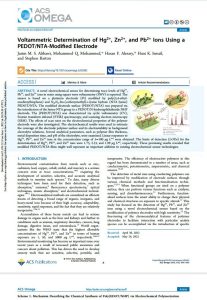Dr. Hasan Faisal Alesary , who is a lecturer at Faculty of Science / University of Kerbala, has published a joint scientific research with a research team from University of Basra, Koya University in Kurdistan region, and University of Kingston London, which is entitled (Voltammetric Determination of Hg2+, Zn2+, and Pb2+ Ions Using a PEDOT/NTA-Modified Electrode) in ACS OMEGA journal . Which is exported from America and registered in Scopus containers (ASC) Q1
The research aims at synthesize a new electrochemical sensor using lysine NTA (which is considered a clicand), which is covalently bound to a polymeric film (EDOT) on a platinum electrode.
The research shows that the polymeric film can be used to detect trace amounts of polluting metals in aqueous samples, and the new poly-EDOT/NTA modified electrode which was thus produced showed excellent efficiency in detecting low concentrations of Hg2+, Pb2+ and Zn2+ ions in water.
The study concludes that this project focuses on the importance of manufacturing functional membranes that can be used as electrochemical sensors for metal ions in an aqueous solution.
In his abstract, Dr. Hasan Alesary says, “A novel electrochemical sensor for determining trace levels of Hg2+, Pb2+, and Zn2+ ions in water using square wave voltammetry (SWV) is reported. The sensor is based on a platinum electrode (Pt) modified by poly(3,4-ethylenedioxythiophene) and Nα,Nα-bis-(carboxymethyl)-l-lysine hydrate (NTA lysine) PEDOT/NTA. The modified electrode surface (PEDOT/NTA) was prepared via the introduction of the lysine-NTA group to a PEDOT/N-hydroxyphthalimide NHP electrode. The (PEDOT/NTA) was characterized via cyclic voltammetry (CV), Fourier transform infrared (FTIR) spectroscopy, and scanning electron microscopy (SEM). The effects of scan rates on the electrochemical properties of the polymer electrode were also investigated. The electrochemical results were used to estimate the coverage of the electrode polymer surface and its electrostability in background electrolyte solutions. Several analytical parameters, such as polymer film thickness, metal deposition time, and pH of the electrolyte, were examined. Linear responses to Hg2+, Pb2+, and Zn2+ ions in the concentration range of 5–100 μg L–1 were obtained. The limits of detection (LODs) for the determination of Hg2+, Pb2+, and Zn2+ ions were 1.73, 2.33, and 1.99 μg L–1, respectively. These promising results revealed that modified PEDOT/NTA films might well represent an important addition to existing electrochemical sensor technologies.”

































































